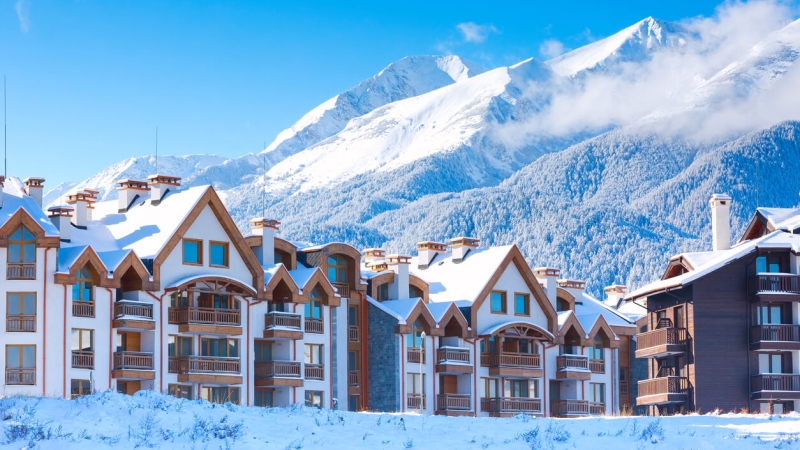Travel to winter tourism destinations, such as ski and snowboard resorts, accounts for a large sector of the hospitality industry. And as travel demand grows, so too does the need for effective ski resort marketing campaigns and strategies. That's where this blog post comes in.
According to the 2020 International Report on Snow & Mountain Tourism, the number of annual worldwide skier visits sits at around 400 million. North America ranks second in visits per year at 21%, while the Alps ranks first at 43%. In other words: There’s a massive chunk of travelers out there looking for an idyllic mountain getaway, and it’s time to ensure that you get your cut of the crust.
In this blog post, we provide expert tips and proven strategies to help boost your ski resort marketing efforts, starting with understanding your target audience all the way down to ideas for seasonal campaigns and food and beverage offerings.
Reinvigorate your ski resort marketing in 10 easy steps:
1. Dig into your mix of sales.
How often do you analyze your mix of sales? Do you know how much of your revenue comes from groups? What about events, conferences, weddings, same-day bookings, and so on? Better yet, do you know how much of your marketing is targeting those different customer types?
If you want to connect with your guests, you have to know who they are. To get started, analyze your revenue reports and note how much business is coming from each of the following market segments:
- Groups
- Weddings
- Accommodations and events
- Events only
- Packages or services (spa, outdoor adventures, etc.)
- Corporate business
- Conventions
- Winter sport travel
Individual market segments will vary based on each property’s location, size, amenity offerings, etc. Dig deeper into the segments that most affect your sell rate.
2. Get to know your comp set.
Improving your marketing efforts doesn’t mean focusing solely on the benefits of your property; it’s also about focusing on what sets you apart from the competition. Do you know which other ski resort properties are in your comp set?
When determining which properties your marketing is competing directly against, consider the following:
- What ski resort properties are in your general proximity?
- Which of those ski resort properties targets similar customers?
- Are any of those ski resort properties under the same brand umbrella as you?
- Which ski resort properties have similar amenities and services?
- Which ski resort properties have similar pricing?
Create a spreadsheet outlining different details for each property: Rates, guest rooms, amenities, F&B options, event spaces, packages offered, rate ranges, etc. This will give you a clear, comprehensive view of the hotels you're selling against.
3. Prepare to sell against your competition.
Once you’ve appropriately identified your competition, it’s time to overshadow their marketing efforts and direct their business to you! Use online resources such as their brand.com site, TripAdvisor, Facebook, etc. to get a better overall understanding of the energy and offerings provided by each property.
- Do they offer successful packages you might want to consider reinventing for your property?
- What do their meeting packages look like?
- Do they offer flat-rate event or group pricing, or do they quote on a case-by-case basis?
- What do their guests say about them online?
- Do they have a social media presence? If so, what’s it like?
- Are you competing well against them in Google searches?
- Are they listed on Cvent’s Mountain Destination Directory?
Additionally, consider stopping by one day for breakfast or lunch to see “behind the scenes.” The goal is not to steal from other properties; guests can sense authenticity. The goal is to understand who is in your market, learn what they offer, and see what works versus what doesn’t. Learn from the mistakes of other properties and find inspiration to amp up your own marketing.
4. Create event packages.
Create and market event packages that include accommodations, F&B specials, and event space, if available. Advertising packages with “per person” pricing can be appealing to those interested in booking conference space, meetings, group events, or weddings. This form of package marketing can also assist with early-stage budgeting and help travel planners identify their short-list of potential properties.
For hotels and resorts, per-person pricing is a revenue-boosting strategy that can increase food and beverage profits by bundling meal packages with overnight accommodations and event space.
To ensure that your packages are available for professional travel planners and group contacts to see, make sure that your offers and pricing options are active and up-to-date within the Cvent Supplier Network.
5. Create unique F&B packages.
For ski resort properties looking to increase individual travel, appeal to families, or fill need dates, consider creating specialized service packages that include meals or dining services for travelers. Romance packages, like a “Honeymooners Hideaway” package, and unique offerings, like a “Friend's Trip” special, can help your property appeal to a larger audience.
You can also create short-term specials that advertise amenities — such as a “Summer Spa Package” — focused on the incorporation of summertime herbs, or an intimate “Chef’s Christmas Dinner” that offers an exclusive menu for an increased price. Market these specials during need dates to bring in additional revenue or during peak seasons to increase your revenue growth.
6. Maximize marketing your menu.
Ski resort travel isn’t solely based on the desire for scenic exercise; it’s also about retreating and relaxing. After an exhausting day, guests want delicious food.
Create a one-of-a-kind menu that’s both affordable and appealing. Consider creating specialty breakfast items, brunch deals, to-go boxed lunches, happy hour specials, or dinner items that you promote on your website and social media.
Additionally, take professional-level photos for your menu. If your property has a photographer on staff or on call schedule an afternoon where they can meet with your chef to take photographs showcasing the best you have to offer. You could also help create an exclusivity driver with specialty menus that are only available during your restaurant’s slow hours and are “reservation only.”
Make sure that your property has a dining account on Yelp so that you're accessible to its massive audience.
7. Get active online.
This is perhaps the most important step when it comes to effective ski resort marketing, but it only means so much if you don't take some — or all — of the above ideas into consideration. That said, maximizing your online reach through social media, your website, and online directories like the Cvent Supplier Network and TravelNotes, should absolutely be a priority.
Reach out to area CVBs, tourism offices, and colleges and universities to ensure that your property is listed and that your information is up-to-date and accurate. As a rule of thumb, your property should probably be listed everywhere your competition is.
If it’s not already, online marketing should be incorporated into your marketing budget. Advertise online via Facebook, Instagram, and Tripadvisor. Create social media pages that highlight your amenities, unique services, guest testimonials, and employee appreciation efforts.
Additionally, consider creating a blog that highlights local attractions, area history, fun guest experiences, and so on. Prioritize SEO and resort-specific keywords in blog posts and reviews to help boost search traffic to your site.
Let us help you boost your ski resort marketing today
8. Appeal to groups.
Set up and promote packages and special rates that appeal to groups of all kinds (social, corporate, conferences, weddings, etc.). For example, provide deeper discounts for groups that book overnight guest rooms, ski packages, and meeting space, and share those discount opportunities throughout your marketing channels.
Analyze the amount of group business coming into the market and see how you stack up against competing properties with Cvent’s Group Competitive Set Dashboard. Ski resort properties can see where they rank amongst the comp set, how well they appeal to various groups segments, bid on group business, track group revenue, and more.
9. Attract repeat customers with seasonal memberships or loyalty programs.
Some guests and travelers want to get a good value just as much as they want to feel valued. They want to know that their loyalty is recognized and appreciated. Show your guests how much you appreciate the fact that they chose to spend their money at your property when there were other options to select from. Ensure them that you respect and honor them by providing them with value. For example ...
You can appeal to seasonal travelers and bring in first-time travelers with membership packages that provide more value than individual bookings.
“Book three nights with a Mountain Pass to receive a free spa treatment for two!”
To provide additional value to repeat guests, offer a loyalty program that rewards frequent travelers by providing discounts on amenities, resort services, or dining specials.
“Ripper-level members receive a complimentary welcome basket and a bottle of wine upon arrival!”
10. Connect with your guests personally.
Many travelers, especially repeat seasonal travelers, want to feel a personal connection when they choose their home-away-from-home. To achieve this via marketing, experiment with sending personalized emails, quarterly newsletters, or personalized texts to keep your guests updated about seasonal specials, renovations, property updates, and employee recognition. Not only will this help travelers feel personally connected to you, it may just help keep your ski resort property at the front of their mind when they book their seasonal travel.
A successful ski resort marketing strategy is built from the ground up!
Understanding your customer base, identifying their needs, meeting their needs, and exceeding their expectations are all vital parts of a successful marketing strategy. The better you understand your customers and your competition, the better you can appeal directly to your target audience and increase your sales through marketing efforts.
Up next, take your marketing efforts a step further with our deep dives into content marketing, Facebook marketing, and digital marketing as a whole.








